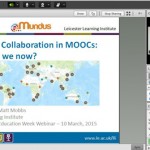eMundus at the Open Education Week

The eMundus project organized six webinars during the last Open Education Week. The Universidad Internacional de la Rioja (UNIR), through UNIR Research, (the Spanish partner) was the institution that hosted all the webinars, which objective was to spread findings and to engage as many actors as possible in the debate on Open Education and international academic cooperation (including MOOCs and Virtual mobility).
Webinar 1: “Awarding academic credit for free online OER courses: Lessons from the OERu”

Wayne Mackintosh (OERu, New Zealand) talked about the Open Education Resource (OER) Foundation, an independent, not-for-profit organization that provides leadership, networking and support for educators and educational institutions to achieve their objectives through open education. “OER is a sustainable and renewable resource”, he stated.
About Higher Education, Mackintosh claimed that there is an unsatisfied demand, and will be necessary more than 100 million additional places by 2025. The main objective of the OER University is to provide free learning opportunities for all students worldwide.
The webinar, which discussant was Cristina Stefanelli (SOPHIA, Italy), also dealt with research on accrediting learners using OER and assessing for formal academic credit. Mackintosh showed traditional approaches (transfer credit, challenge for credit, course assignments, automated assessment and recognition of prior learning) and emerging approaches (competency-based, open badges and VMPass).
Webinar 2: “Credit and Collaboration in MOOCs: Where are we now”

Terese Bird and Matt Mobbs (University of Leicester, UK) analyzed the intersection of ‘open’ and ‘collaboration’, with examples of MOOC credit and collaboration from around the world.
Bird drew different learning scenarios. For example, students that are encouraged to apply to university allowing prior credit from community colleges and from MOOCs offered at that university. Students who would not have been able to consider university without this could now apply and earn a degree in two years. Thus, the university has reached new students.
The session, which discussant was Zoraini Wati Abas, also addressed some future learn examples, like collaborations between universities and cultural institutions. One example was Leicester FutureLearn, the agreement between University of Leicester and Museum of Liverpool. On the other hand, the experts showed Mozilla Open Badges, electronic credentials that any university, organization or otherwise can issue. They also talked about different MOOCs connected with private sector.
Webinar 3: “OER is simpler than you think”

Rory McGreal (Athabasca University, Canada) stated that the challenge for the 21st Century is how to educate all the new learners (about 100 million by 2025) taking into account that Higher Education sector is under pressure (budgets cuts, marketization, massification and youth unemployment).
In this context, virtual mobility gains importance, using ICT to connect students in different countries to activities, courses and programmes. “Online learning replaces travel even within cities”, claimed McGreal.
The webinar, which discussant was Vasudha Kamat (SNDT Women’s University TBC), also showed the troubles of credit transfer. In North America this is easy in first two years but there are problems for specific programmes and also in upper years. In Europe, Bologna Process also has barriers. “The right to have your knowledge and skills recognized is a Human right”, remembered McGreal.
Webinar 4: “Transnational Virtual Mobilities”
Wim Van Petegen (K.U.Leuven, Belgium) showed different definitions of the concept ‘virtual mobility’. The most suited was a set of ICT supported activities, organized and institutional level, that realize of facilitate international, collaborative experiences in a context of teaching and/or learning.
Virtual mobility has an international dimension and intercultural competence. Internationalisation is about the integration of an international dimension into the research, teaching and services function of Higher Education (credit, degree, global, system and excellence mobility). Intercultural competence is about the ability to understand and respond to cultural difference in increasingly sophisticated ways.
Van Petegen also talked about Virtual Mobility Co-Laboratory (VMCOLAB), an European co-laboratory for the integration of virtual mobility in Higher Education Innovation and Modernisation Strategies. The session, which discussant was Rosario Freixas (Universidad Nacional Autónoma de México), concluded that Higher education is international, intercultural, intergenerational and interdisciplinary thanks to (or despite) new educational technologies.
Webinar 5: “The impact of Open Education on internationalisation models of universities”
Fabio Nascimbeni (UNIR, Spain) set out to the participants different questions for reflection: Do you collaborate internationally? Do you implement Open Education? Do you believe that Higher Education (international) collaboration can be empowered by Open Education?
“Open Education is not a solution to the challenges of reducing the unitary cost of Higher Education but rather a way to help establish long-term international partnership, aiming for an open international setting where universities cooperate”, stated Nascimbeni.
We are in a changing environment –added the expert–, with massification of Higher Education, greater student mobility across nations, increased use of ICT, spread of excellent institutions worldwide and increased need to generate income from tuition. The session, which discussant was Irina Smirnova (MESI, Russia), showed the role of eMundus project within this changing environment.
Webinar 6: “Integration of OER with regular/formal academic programmes”
Daniel Burgos, Vice-chancellor for Research & Technology at UNIR, talked about Open Education Resources in official academic programmes, paying attention to where is the accreditation, the certified quality, the competence-based approach and the credit recognition.
Burgos showed the details of L.I.M.E model, which main objective is the implementation of a recommendation model for informal and formal learning (Learning, Interaction, Mentoring and Evaluation). Alberto Corbí (UNIR) explained its implementation, based on an IMS Learning Tool Interoperabillity.
The Vice-chancellor explained the rules of the application case of L.I.M.E and showed other related projects in which UNIR is partner, like VMPass or eMundus, and also the UNESCO Chair on eLearning, managed by UNIR Research.
Burgos concluded with an iceberg metaphor. Formal learning only means a 20% of the global learning; informal learning covers the 80% that we couldn’t see but exists. The discussant of the webinar was Carlos Montenegro, (Universidad Distrital Francisco José de Caldas, Colombia).



